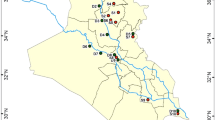Abstract
Sixty-seven dust collectors were installed in 47 sites all over Kuwait. Nine of these sites contain four collectors for radionuclide collection. The monitoring of dust fallout and associated pollen was conducted for 2 years from August 2009 to August 2011. The highest dust depositional rates were detected within the western areas of Kuwait. The annual amount of dust in Kuwait varies from 10 to 1065 unit with an average of 278 t/km2. The year 2010–2011 was found dustier compared to 2009–2010 by 43 %. The analysis leads to a conclusion that the northwestern, western, and northern winds play a key role in producing dust within Kuwait. Regional areas represent the dominant sources of dust fallout, while local sources contribute appreciable amounts. The very fine and fine sand particles originate from local sources as they move in the form of saltation for a short distance and represent 37 % of the average dust fallout percentages in Kuwait. There is a trend of fining in mean size of dust particles towards the east and the northeast. Mineralogically, carbonates and quartz are the major components of dust in Kuwait, feldspars are found in considerable amounts. Other minerals in the dust are gypsum, anhydrite, bassonite and heavy minerals. Carbonates are more and quartz is less towards the coastal areas compared to desert areas. Natural 40K and 210Pb, man-made (anthropogenic) 137Cs, and cosmogenic 7Be radionuclides were determined. The average monthly depositional rates were 35.4, 11.2, 13.2 and 0.3 Bq m−2 for 7Be, 210Pb, 40K and 137Cs, respectively, which are were comparable to similar climatologically areas around the globe. Pollen originates predominantly from regional sources. However, the presence of a large amount of pollen from Haloxylon sp. Cyperus sp. indicates that close-by regional and local areas are a major contributor of fallen dust.






Similar content being viewed by others
References
Al-Dabbas M, Ayad AM, Al- Khafaji R (2011) The mineralogical and micro-organisms effects of regional dust storms over Middle East region. International Journal of Water Resources and Arid Environments 1(2):129–141, ISSN 2079–7079
Al-Dousari AM (2009) Section III: recent studies on dust fallout within preserved and open areas in Kuwait. In: Bhat NR, Al-Nasser AY, Omar S (eds) Desertification in arid lands: causes, consequences and mitigation. Kuwait Institute for Scientific Research, Kuwait, pp 137–148
Al-Dousari AM, Al-Awadhi J (2012) Dust fallout in northern Kuwait, major sources and characteristics. Kuwait J Sci 39(2A):171–187
Al Enezi E, Al-Dousari A, Al-Shammeri F (2014) Modeling adsorption of inorganic phosphorous on dust fallout in Kuwait. Journal of Engineering Research 2(2):1–14
Awadh SM (2012) Geochemistry and mineralogical composition of the airborne particles of sand dunes and dust storms settled in Iraq and their environmental impacts, Environmental Earth Sciences, ISSN 1866–6280, Volume 66, Number 8. Environ Earth Sci 66:2247–2256
Baskaran M (2011) 210Po and 210Pb as atmospheric tracers and global atmospheric 210Pb fallout: a review. J Environ Radioact 102:500–513
Brost R, Feichter J, Heimann M (1991) Three-dimensional simulation of 7Be in a global climate model. J Geophys Res Atmos 96:22423–22445
Meng Z, Lu B (2007) Dust events as a risk factor for daily hospitalization for respiratory and cardiovascular diseases in Minqin, China. Atmos Environ 41:7048–7058
Peterson ST, Junge CE (1971) Sources of particulate matter in the atmosphere. In: Kellog WW, Robinson GD (eds) Man’s impact on the climate. MIT Press, Cambridge, pp 310–320
Preiss N, Genthon C (1997) Use of a new database of 210Pb for global aerosol model validation. J Geophys Res Atmos (1984–2012) 102:25347–25357
Safar MI (1980) Frequency of dust in day-time summer in Kuwait. Directorate General of Civil Aviation, Kuwait
Walker PH, Costin AB (1971) Atmospheric dust accession in south-eastern Australia. Aus J Soil Res 9:1–5
Acknowledgments
The authors express their gratitude to the Kuwait Foundation for the Advancement of Science (KFAS) for the project (2008-1401-01) and the Kuwait Institute for Scientific Research (KISR) for funding the projects ECO41K and EC063C rather than general activities EC055G and EC058G.
Author information
Authors and Affiliations
Corresponding author
Additional information
This article is part of the Topical Collection on DUST
Rights and permissions
About this article
Cite this article
Al-Dousari, A.M., Aba, A., Al-Awadhi, S. et al. Temporal and spatial assessment of pollen, radionuclides, minerals and trace elements in deposited dust within Kuwait. Arab J Geosci 9, 95 (2016). https://doi.org/10.1007/s12517-015-2182-z
Received:
Accepted:
Published:
DOI: https://doi.org/10.1007/s12517-015-2182-z




